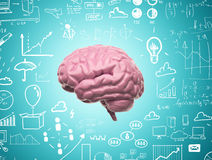Brains are not billions of little computers
Despite the hype. Also, life forms are not machines and neurons are not neural networks Much popular literature leaves the impression that living organisms are machines or even billions of them linked together. For example, at Medium, we learn,
Much popular literature leaves the impression that living organisms are machines or even billions of them linked together. For example, at Medium, we learn,
Brains receive input from the outside world, their neurons do something to that input, and create an output. That output may be a thought (I want curry for dinner); it may be an action (make curry); it may be a change in mood (yay curry!). Whatever the output, that “something” is a transformation of some form of input (a menu) to output (“chicken dansak, please”). And if we think of a brain as a device that transforms inputs to outputs then, inexorably, the computer becomes our analogy of choice…
Your cortex contains 17 billion neurons. To understand what they do, we often make analogies with computers. Some use these analogies as cornerstones of their arguments. Some consider them to be deeply misguided. Our analogies often look to artificial neural networks: for neural networks compute, and they are made of up neuron-like things; and so, therefore, should brains compute. But if we think the brain is a computer, because it is like a neural network, then now we must admit that individual neurons are computers too. All 17 billion of them in your cortex; perhaps all 86 billion in your brain.
And so it means your cortex is not a neural network. Your cortex is a neural network of neural networks. Mark Humphries, “Your Cortex Contains 17 Billion Computers” at Medium
Dizzying.
Of course, as neurosurgeon Michael Egnor points out,
…the brain will seem like a machine if we study it like a machine. We live in a mechanical age so it is no surprise that the brain seems like a machine to us. It is not entirely illogical to study the brain as a machine but we must remember that the answers we obtain will be as biased as the questions we ask.
Indeed. If living systems are billions of linked computers, it is only natural to assume that machines work like living systems. But do they? No, says a Google product manager:

Yariv Adan, project lead, Google Assistant
While the high level and conceptual thinking of ANNs (artificial neural networks) is inspired by neurons and neural networks in the brain , the ML implementation of these concepts has diverged significantly from how the brain works. Moreover, as the field of ML progressed over the years, and new complex ideas and techniques have been developed (RNNs, GANs, etc) — that link has further weakened. Yariv Adan, “Do neural networks really work like neurons?” at Medium
He goes on to say that “The complexity and robustness of brain neurons is much more advanced and powerful than that of artificial neurons” and “the neurons in the brain are implemented using very complex and nuanced mechanisms that allow very complex non linear computations,” among many other things. He sees the brain mainly as a source of inspiration rather than a model.
Of course, that raises a question whether things can be going on in the brain that cannot be modeled in a computer, whether the brain is a source of inspiration or not. The human form is a source of inspiration for classical sculptors, for example, but the human form does much that their works of art cannot do and no one expects them to do in order to achieve their purpose.
But organisms differ from machines in a fundamental way, according to philosopher Sune Holm at the University of Copenhagen. Holm’s specialty is synthetic biology, the attempt to create life form scratch:
One of the most basic objections to the identification of organisms and machines is that their behaviour cannot be reduced to the activities and relations of their parts.
In contrast to a mechanical watch, whose activity is fully determined “from the bottom up” by the activities and organisation of its parts, organisms influence the activities of their parts.
For example, your muscles start to grow if you start to exercise. Moreover, the parts of a watch exist before the watch does. It is not the watch itself that builds its own parts.Sune Holm, “Why Living Organisms Aren’t Machines” at RealClearScience
 Well, there’s more to the differences though, isn’t there? Living organisms don’t just create themselves; they receive a life that is passed on through other organisms. Termite mound expert J. Scott Turner noted in Purpose and Desire: What Makes Something “Alive” and Why Modern Darwinism Has Failed to Explain It that life forms exist in a dance with their environment (homeostasis) that requires constant adjustment, an adjustment generated by their inner drive to continue in existence. How does the drive come to be there? So pervasive is this dance in insect colonies that, for example, an individual termite can be seen as a neuron in a giant crawling brain. But why do life forms seek to continue in existence, in homeostasis?
Well, there’s more to the differences though, isn’t there? Living organisms don’t just create themselves; they receive a life that is passed on through other organisms. Termite mound expert J. Scott Turner noted in Purpose and Desire: What Makes Something “Alive” and Why Modern Darwinism Has Failed to Explain It that life forms exist in a dance with their environment (homeostasis) that requires constant adjustment, an adjustment generated by their inner drive to continue in existence. How does the drive come to be there? So pervasive is this dance in insect colonies that, for example, an individual termite can be seen as a neuron in a giant crawling brain. But why do life forms seek to continue in existence, in homeostasis?
Dr. Holm thinks that living organisms are the product of natural selection and thus “more like the products of a tinkerer than the results of a master engineer’s rational design.” Yet he acknowledges that “there is also widespread recognition that the production of complex synthetic organisms ‘from scratch’ is not around the corner.”
We cannot simply “re-tinker” them, it seems. Which is odd when you think of it. If he is correct about life forms merely being tinkered into existence, we ought to be able to re-tinker them.
Overall, the analogy between life forms and machines like computers is not particularly convincing, on close examination.
See also: Yes, your brain is a machine—if you choose to see it that way (Michael Egnor)
and
Can machines really learn? (Michael Egnor)

